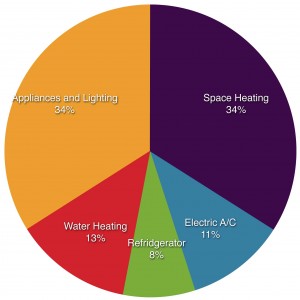Building green saves money, creates a healthier (less toxic) environment, creates higher air and water quality, minimizes your building’s environmental impact, increases your local economy, increases your home’s value, may give you state and federal tax incentives … I could go on and on! The real question is why wouldn’t you build green?
This pie chart shows the breakdown of energy use in your home according to U.S. Department of Energy (2010).
“Americans spend more than $160 billion a year to heat, cool, light, and otherwise power their homes”
– U.S. Department of Energy
Appliances
The money saved by building a green home with energy-reducing appliances can add up to $235 (energy star estimate) or more per year. Green appliances use less energy and water than standard models. For instance, an energy efficient washing machine uses 50% less energy and only 18 to 25 gallons of water per full load, compared to 40 gallons of water in regular models. According to a Natural Resources Defense Council article, qualified, energy efficient dishwashers can save $25, washing machines $110 and refrigerators $100 or more a year on utility bills.
Water
Average households use around 260 gallons of water each day.Green home builders who integrate water saving fixtures into home designs will save an average of $2,000 on the lifetime of high efficiency toilets alone. Green energy shower fixtures cost around $20 each but save 25 to 60% in water usage. Less water usage means less wear and tear on pipes and water pumps, and less electricity to run them. The third largest energy expense in any home is water heating, which usually makes up 13% of total utility bills and uses 14 – 15% of household energy. Install a solar, tankless, heat pump or other energy efficient hot water heater and you will not only reduce your carbon footprint but also save on expenses.
Energy
The key to maximizing your energy savings are energy efficient building plans and designs. Simple adjustments such as low emissivity double-paned windows or passive cooling and heating strategies produce considerable long term energy savings. According to “Living Green” magazine, builders that spent $3,000 on green upgrades were able generate savings of 40% or more on the energy performance of their buildings. Not only does the extra construction cost end up paying for itself, it also ends up saving a substantial amount and lowers the environmental impact of your home.
